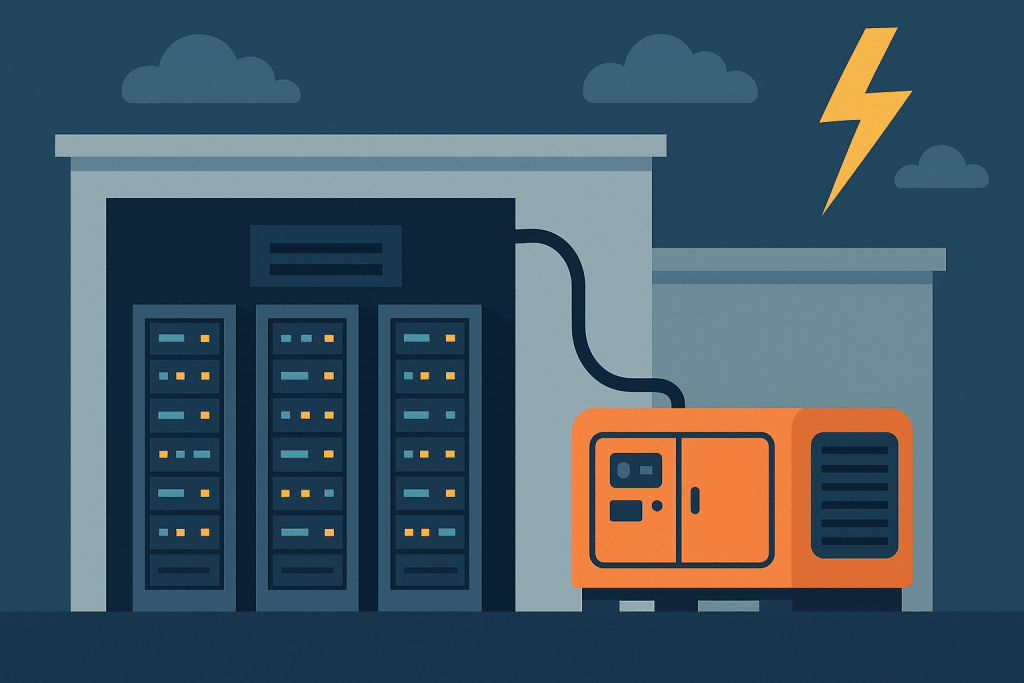
When we open a website, place an order in an online store, or work with a corporate CRM, we rarely think about what’s happening “behind the scenes.” Yet even a few minutes of server downtime can cause serious losses — from losing customers to damaging databases. That’s why every professional data center is built on one principle: to operate continuously, no matter the circumstances.
In times of energy instability — especially during power outages — backup power becomes the key to reliability. Thanks to multi-layered systems, from batteries to powerful diesel generators, data centers can stay operational for hours or even days without external electricity.
UPS — The First Line of Defense
When voltage disappears in the city grid, the Uninterruptible Power Supply (UPS) system kicks in instantly. It takes on the load, powering servers, routers, switches, cooling, and security systems. Typically, a data center UPS consists of several modules connected in parallel. This not only distributes the load but also provides redundancy — if one module fails, the others keep working.
There are two main types of systems — battery-based (using lithium or lead-acid batteries) and supercapacitor-based, which release energy instantly. Their autonomy usually lasts from 5 to 15 minutes — just enough time for generators to start. But it’s the UPS that ensures the main goal: uninterrupted power — without flicker, delay, or data loss, even for fractions of a second.
Diesel Generators — The Heart of the Backup System
While the UPS carries the load, the Automatic Transfer Switch (ATS) activates the diesel generators. Their capacity is sufficient to keep the entire data center running — from server racks to air conditioners.
Generators work in sync, maintaining stable voltage and frequency. Large data centers install several units that can alternate or operate together. Fuel tanks are designed for at least 8–12 hours of autonomy, often extended to 24 hours. If an outage lasts longer, special vehicles refill the tanks while the generators are running, ensuring an uninterrupted power supply.
Each generator has its own cooling system and sensors for pressure, temperature, and fuel flow. All this is monitored by a central control system that transmits real-time data to engineers. If any parameter deviates from the norm, the system immediately sends alerts to prevent a failure.
Automation and Load Balancing
A modern data center requires no manual intervention during power switching. Everything happens automatically: the UPS reacts within milliseconds, the ATS determines the energy flow, and generators start autonomously. As a result, no server “notices” the loss of the main power source.
When electricity returns, the system switches back just as seamlessly, recharging UPS batteries and shutting down the generators. The entire process takes only seconds and causes no interruptions.
Moreover, the data center’s power system is divided into multiple independent lines. If one circuit fails, the others continue supplying power — this is known as N+1 or 2N architecture, where every component is duplicated. This design achieves Tier III or even Tier IV reliability, where the failure of one system doesn’t affect overall operation.
The Heat Challenge: Cooling During Outages
When generators are running, the load on the cooling system increases — both the servers and diesel engines generate heat. To handle this, separate cooling circuits are powered by the backup system as well.
Air conditioning, ventilation, and liquid cooling systems maintain a stable temperature — typically 22–25°C. Even a brief rise above that can affect server stability, so temperature is monitored around the clock.
Engineers track every metric — from energy consumption to humidity — to maintain optimal conditions even during prolonged outages.
Regular Testing — The Key to Reliability
Backup power systems cannot simply “wait for their moment.” All components undergo regular testing: generators start weekly or monthly in test mode, UPS units are checked under load, and automatic switches are tested in simulated outage mode.
These tests ensure that everything will respond instantly in a real emergency. Engineers analyze logs, measure response times, voltage levels, and temperatures of batteries and generators. This constant monitoring keeps the system in perfect condition, as even a minor deviation could cause downtime.
Why It Matters for Data Center Clients
For businesses, stability isn’t just convenience — it’s a competitive advantage. When a company’s website or CRM remains online during large-scale blackouts, it builds customer trust. A user may not know the data center has been running on diesel for hours, but they see what matters — flawless performance.
In a world where energy stability can’t be guaranteed, backup power is not a luxury — it’s a necessity. Companies that choose reliable data centers gain true confidence in tomorrow.
Conclusion
A backup power system is a complex organism where every second counts. UPS units hold the load in the first minutes, generators take over for hours or even days, and monitoring systems track every parameter in real time. Thanks to this, data centers stay “online” even when an entire city is in darkness.
That’s how Server.UA operates — a Ukrainian data center that combines advanced technology, professional monitoring, and a well-designed backup power system. Here, stability isn’t a promise but an engineering reality. Server.UA servers keep running even when electricity disappears everywhere else, ensuring uninterrupted operation of your business, websites, and services.

Leave a Reply